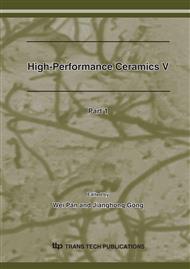p.675
p.679
p.683
p.686
p.688
p.691
p.694
p.697
p.701
Control of Ceramic Material Microstructure with Super High Magnetic Field
Abstract:
A new control method of the particle orientation structure with super high magnetic field is studied for Al2O3 ceramics. Al2O3 slurry was made with two types of Al2O3 particles, which one was spherical shape of, and the other one was elongated shape of. The Al2O3 ceramics of orientation structure was fabricated by drying the Al2O3 slurry under the super high magnetic field, cold isostatic pressing (CIP) and sintering. Effects of particle shape, particle size, the solid loading, slurry viscosity, dispersant content and the magnetic field strength on the particle orientation structure were examined in detail. The experimental results indicate that even the spherical Al2O3 particles can align under the magnetic field; the particle orientation degree changes with the particle shape and the solid loading under same magnetic field strength conditions, and the elongated particle system is easier to align than the spherical particle system; the particle orientation degree of the Al2O3 ceramics can be controlled by adjusting the particle shape, particle size, solid loading, slurry viscosity, dispersant content and magnetic field strength.
Info:
Periodical:
Pages:
688-690
Citation:
Online since:
February 2008
Authors:
Keywords:
Price:
Сopyright:
© 2008 Trans Tech Publications Ltd. All Rights Reserved
Share:
Citation:


